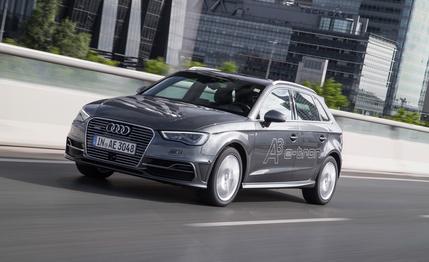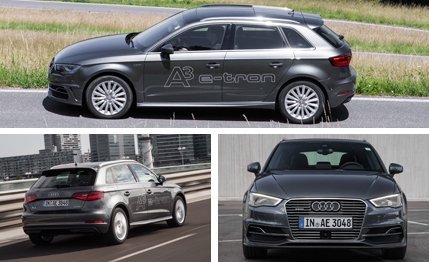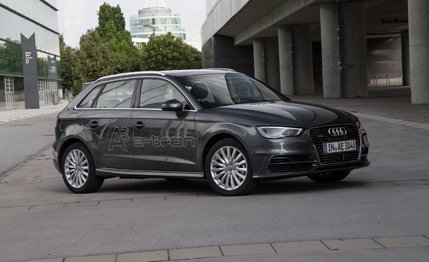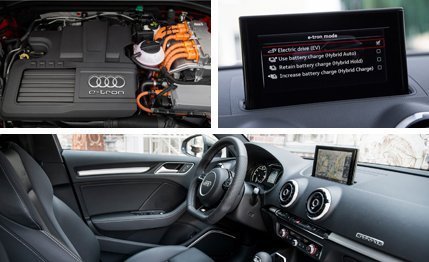 First Drive Review
First Drive Review
Here’s what Audi promises with the new A3 e-tron: a compact luxury hatchback that can achieve 157 mpg but also hit 138 mph. Based on the latest A3 Sportback—that’s Audi-ese for “five-door A3”—this model packs a 150-hp 1.4-liter turbocharged four-cylinder, a 102-hp electric motor, and enough battery storage to enable up to 31 miles of full-electric operation.
But the car is too good to be true. The mpg figure above is based on European standards, which are jiggered by the authorities to promote electrification by maximizing opportunities for vehicles to use their all-electric modes. Real-world drivers rarely achieve anything close to EU consumption estimates. In terms of this A3, when driven short distances and plugged in regularly, it won’t use any gasoline at all. But as soon as the batteries are depleted, fuel use will be essentially the same as a conventionally powered car.
Magic Numbers!
We found this out last week while driving 50-mile loops that wound through Vienna city traffic and into the nearby mountains. During our first stint, we drove moderately and attempted to maintain a full battery by using the "hold" and "charge" modes. The former locks out the electric portion of the drivetrain (in case you want to save your EV mileage for, say, a restricted city center), whereas the latter forces the engine to act as a generator to maximize energy recuperation. In doing so, we saw an indicated 34 mpg in the cluster and returned with a completely full battery. On our second run, we started out using solely electric power, ran until the batteries were empty, and then put the car into "auto" mode to allow it to both recapture energy and feed it back to the powertrain as it saw fit. We also may have possibly set an Austrian plug-in-hybrid speed record. The result: 42 mpg and a drained battery. Less aggressive journalists, however, managed 100 mpg and a depleted battery, too. For what it’s worth, we figure the EPA will rate this car at 95 MPGe combined in gas-electric operation.

The 96 liquid-cooled lithium-ion cells enabling such performance are recharged through a port located behind the Audi grille rings. According to Audi, the recharging process in Europe takes a good two hours with a high-voltage outlet and almost four hours using a household plug; those times aren’t exactly Tesla-quick, and you can figure on more time using lower-voltage U.S.-spec outlets.
Assuming that you drive very short distances every day and electricity is cheap—or cheaper than in Germany, anyway, which is in the costly process of shutting down its nuclear power plants—the A3 e-tron can be rather inexpensive to operate. Driven over long distances, the savings dwindle, and customers might well be better off with an A3 TDI.
Electricity is a Buzzkill
We’ll double down on the recommendation of a TDI for the fuel thrifty who actually like to drive. Saddled with an estimated 750 pounds of extra weight, the A3 e-tron doesn’t have much to offer anyone who isn’t into silently accelerating in all-electric mode to 60 mph in about 11 seconds. Yes, the full torque of the electric motor is available in Hybrid mode from 0 rpm and for up to 20 seconds when the battery is full. Yes, the dual powertrains—which produce a combined 204 horsepower—can scoot the A3 e-tron to 60 mph in an estimated 7.5 seconds. Yes, the aerodynamically enhanced top speed of 138 mph is reached without electric power. And, yes, the Volkswagen Group’s excellent six-speed DQ400E dual-clutch automatic does the shifting. But these facts and figures fail to coalesce into something completely satisfying, and the whole isn’t as linear and predictable as a conventional car.

The A3 e-tron’s cornering characteristics are less than scintillating. In fast bends, the car exhibits more body roll than any other A3 we’ve driven to date, and it also tends toward serious understeer. It’s too bad, then, that there is no available sport suspension, as this A3 would benefit from such a setup more than any of its siblings. At least the brakes are fairly well tuned for a hybrid’s, as they offer decent feel and a relatively seamless transition between their regenerative and friction modes. (Push the pedal gently for the former; the latter takes over once you go deeper into the pedal’s travel and for emergency stops.)
The A3 e-tron is far more successful when driven at the moderate speeds for which it is really intended. It launches from a stop using electric power, the transition is smooth when the gasoline engine joins the party, and the engine remains discreetly in the background when it’s running. Things are even more subdued when driving only on electrons, although the electric motor and transmission do wind through gears, creating a sound that resembles a distant tram.
A leisurely pace at least allows those inside to admire the surroundings, as the A3 has what may be the best interior in this segment. As for differences between this car and fossil-fueled A3s, there is basically one—a “power meter” gauge that replaces the tachometer. Beyond the driving modes we already described, additional powertrain control is available by selecting D or S with the gearshift. In D mode, the A3 e-tron sails, which is to say it will shut down and uncouple the powertrain from the drive wheels when coasting on the freeway to minimize friction and fuel consumption. In S mode, the powertrain maximizes energy recuperation. And then there's the Audi Drive Select, which itself offers Comfort, Auto, and Dynamic settings, as well as a mix-and-match mode.

It wasn't easy to fit the e-tron technology under the tight skin of the new A3. In order to make room for the lithium-ion batteries, the gas tank was made smaller and relocated a bit toward the back, under the cargo area. The tank is also now enclosed in a sturdy crash structure. The cargo capacity is lower than that of the regular A3 Sportback and the all-wheel-drive A3 Sportback Quattro. The engine was moved slightly toward the passenger’s side in order to make room for the electronics. And Audi stiffened the structure to deal with the extra weight.
In Germany, the A3 e-tron is priced well above the regular A3, approaching the money asked for the fantastic 300-hp S3. Sales in the U.S. are still a year away. When the A3 e-tron comes here in the summer of 2015 as a 2016 model, we expect Audi to ask $40,000 or so for the privilege of owning one. You will likely be able get an A3 TDI Sportback for much less. The A3 TDI Sportback and the S3 are two of the best compact cars on the market, being luxurious, rewarding to drive, and efficient. Unless your specific commuting needs call for a plug-in hybrid—short drives, lots of time available for charging—our advice would be not to wait for the e-tron.